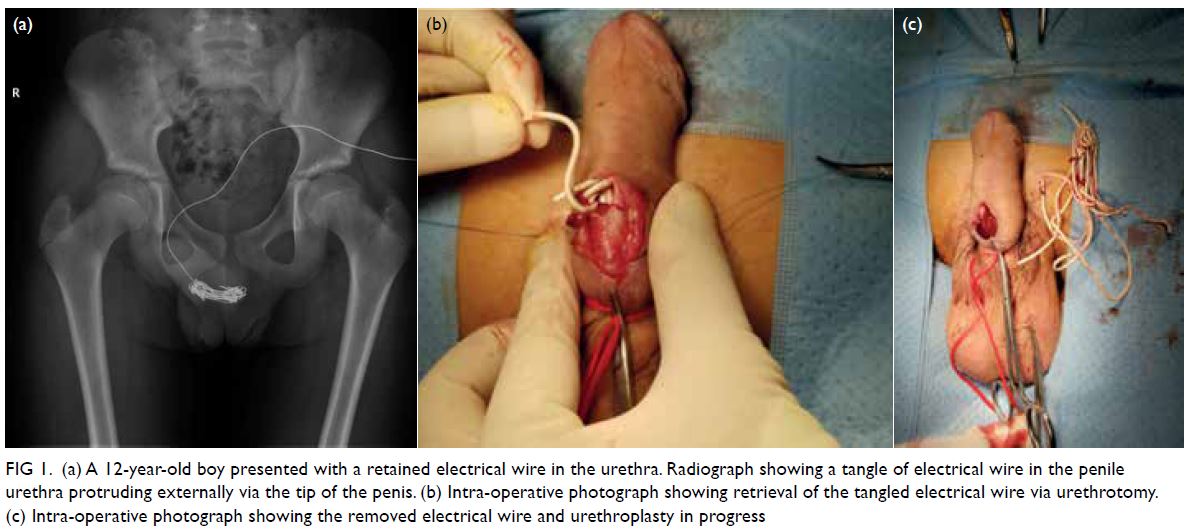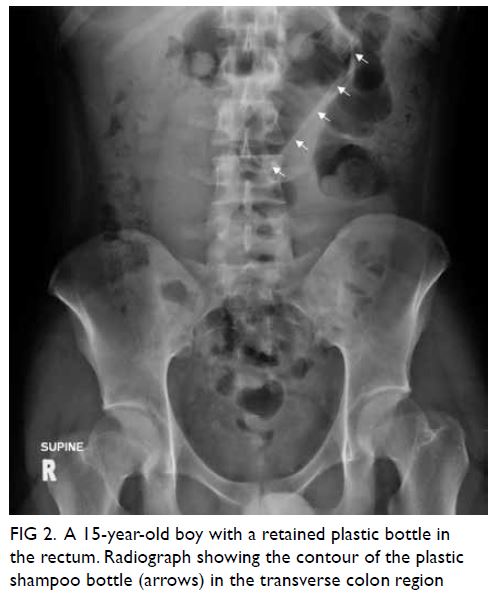Hong Kong Med J 2021 Apr;27(2):142–4 | Epub 7 Apr 2021
© Hong Kong Academy of Medicine. CC BY-NC-ND 4.0
CASE REPORT
Self-inserted foreign bodies during COVID-19:
two case reports
Adrian CH Fung, MB, BS, MRCS; Bess SY Tsui, MB, ChB, FRCS; Sammi YS Wong, MB, ChB, FRCS; YH Tam, MB, ChB, FRCS
Department of Surgery, Princes of Wales Hospital, Hong Kong
Corresponding author: Dr Adrian CH Fung (fungchiheng@gmail.com)
Case reports
Patient 1
In June 2020, a 12-year-old boy presented to the
emergency department with a 1-day history of
retained electrical wire in the urethra. The electrical
wire had been self-inserted into the urethra in
an attempt to relieve “urethral itchiness”. He
reported pain and gross haematuria as a result of
this insertion. He and his mother had been unable
to remove the wire. Upon admission, physical
examination and plain abdominal radiograph
revealed a tangle of electrical wire at the penile
urethra with 20 cm of wire protruding externally via
the urethral meatus (Fig 1a). Removal of the foreign
body with 2% xylocaine gel was attempted but failed
so emergency surgery was arranged. Despite general
anaesthesia, the tangled electrical wire could not be
removed by applying traction to the external end.
Surgical removal through urethrotomy at the mid-penile
urethra was performed (Fig 1b). The wire
was fragmented and retrieved completely, and the
penile urethra was reconstructed with urethroplasty
(Fig 1c).

Figure 1. (a) A 12-year-old boy presented with a retained electrical wire in the urethra. Radiograph showing a tangle of electrical wire in the penile urethra protruding externally via the tip of the penis. (b) Intra-operative photograph showing retrieval of the tangled electrical wire via urethrotomy. (c) Intra-operative photograph showing the removed electrical wire and urethroplasty in progress
Upon further discussion with the patient’s
mother, she revealed that the patient had been
having difficulty settling into school and adapting
to everyday life following their recent immigration
from Taiwan. With school suspended during the
coronavirus disease 2019 (COVID-19) pandemic,
the patient was often left alone at home, worsening
his emotional health. His mother volunteered that
he had no history of insertion of foreign body.
He was assessed by the clinical psychologist who diagnosed limited problem-solving skills and autistic
features with a strong interest in using electrical
wire. Additional parental support was advised and
regular follow-up with the clinical psychologist was
arranged. The patient was discharged 2 days after
his operation with an indwelling urinary catheter in
place for 2 weeks.
Patient 2
In May 2020, a 15-year-old boy was admitted with a 1-day history of a retained plastic bottle in his
rectum. He reported recent onset of constipation and
had inserted a plastic shampoo container per rectum in the hope of inducing a bowel motion. The patient
claimed that the idea for this “regimen” was derived
from an internet search for a remedy for constipation
while school was suspended due to the COVID-19
pandemic. He had no abdominal pain, per rectal
bleeding or fever. Physical examination revealed a
soft non-distended abdomen. No mass or foreign
body was initially felt per rectum. Plain abdominal
radiograph revealed the contour of the plastic
shampoo bottle in the region of the transverse colon
(Fig 2). He was observed overnight in our surgical
ward and repeated per rectal examination the next
morning found that the plastic bottle was just
palpable with a fingertip. The patient subsequently
had a bowel motion with passage of the bottle. He
was given advice about diet and the correct use of
laxatives for constipation prior to discharge on the
same day. His parents were interviewed and advised
to pay more attention to their son’s behaviour at
home.

Figure 2. A 15-year-old boy with a retained plastic bottle in the rectum. Radiograph showing the contour of the plastic shampoo bottle (arrows) in the transverse colon region
Discussion
Self-insertion of a foreign body into a body orifice is uncommon in children and adolescents.1 Urethral
foreign body is even rarer. Motives for teenage
intentional foreign body insertion include risk-taking,
attention-seeking, sexual gratification, self-injurious
behaviour, psychiatric disorder, and self-treatment.2 A wide variety of foreign bodies have
been reported in the literature, including needles,
safety pins, pencils, ball point pens, wire-like objects (telephone cables, feeding tubes, straws, rubber
tubing), toothbrushes, household batteries, and nail
scissors.1 In our patients, electrical wire and a plastic
bottle were self-inserted in the urethra and rectum,
respectively. Patients with urethral foreign body
may present with lower urinary tract symptoms
including dysuria, haematuria, urethral discharge,
and swelling of the external genitalia. Most patients
with self-insertion of a foreign body, because of
embarrassment, seek medical attention only after
the occurrence of complications such as intestinal
obstruction, perforation, genital tract infection, or
abscess formation.3 Diagnosis can be made in most
cases following a comprehensive history taking and
physical examination. Radiological evaluation of
foreign body with plain radiograph to determine size
and number of foreign bodies and their anatomical
relationship with surrounding structures usually
suffices. Nonetheless ultrasound and computed
tomography occasionally may be necessary in
selected difficult cases for surgical planning.1 3
Endoscopy (eg, cystoscopy or sigmoidoscopy) is
considered the first-line option for confirming
and removing the foreign body. Open surgery (eg,
laparotomy, urethrotomy, or suprapubic cystotomy)
has been described for large foreign bodies or when
endoscopic removal is deemed impossible.1 2 3 In
our first patient, cystoscopic removal was deemed
impossible due to tangling of the electrical wire in
the penile urethra; therefore, urethrotomy followed
by urethroplasty was necessary to fragment and
untangle the wire and achieve complete removal. In
addition to removal of the foreign body, this group of
teenage patients should be advised to obtain proper
psychiatric assessment or psychological support as
many of them may have mental health issues.1 2
The COVID-19 pandemic has impacted the
mental well-being of children and adolescents as
a result of strict public health measures. In Hong
Kong, the Education Bureau ordered classes at
all kindergartens and primary and secondary
schools to close from February 2019 until mid-June. Prevention and Control of Disease Regulation
(Cap. 599G) was enforced to restrict the number
of persons in group gatherings in public places to
maintain social distancing. In mainland China,
>20% of college students reported mild to severe
anxiety as a result of isolation measures and school
suspensions in the midst of the pandemic.4 Lack
of contact with peers, reduced opportunities for
stress modulation, increased domestic violence,
and child maltreatment have been reported as
additional threats to the mental health of children
and adolescents. These threats have more impact
on those already disadvantaged, such as those with
physical disabilities, mental health illness, migrant
background, or low socio-economic status.5 Our
centre observed an increase in foreign body-related conditions during this period, with unusual foreign
bodies found at unusual sites. Both patients reported
herein were emotionally and socially affected by
the COVID-19 pandemic. The mental well-being
of children and adolescents should be monitored
and supported, and these mental health challenges
should be addressed with collaboration among
the government, schools, parents, and healthcare
professionals.
Author contributions
All authors contributed to the concept or design of the study,
acquisition of the data, analysis or interpretation of the
data, drafting of the manuscript, and critical revision of the
manuscript for important intellectual content. All authors
had full access to the data, contributed to the study, approved
the final version for publication, and take responsibility for its
accuracy and integrity.
Conflicts of interest
All authors have disclosed no conflicts of interest.
Funding/support
This case report received no specific grant from any funding agency in the public, commercial, or not-for-profit sectors.
Ethics approval
The patients were treated in accordance with the tenets of the Declaration of Helsinki. Verbal patient consent was obtained.
References
1. Prasad Ray R, Ghosh B, Pal DK. Urethral foreign body in
an adolescent boy: report of two rare cases and review of
literature. Int J Adolesc Med Health 2015;27:463-5. Crossref
2. Unruh BT, Nejad SH, Stern TW, Stern TA. Insertion of
foreign bodies (polyembolokoilamania): underpinnings
and management strategies. Prim Care Companion CNS
Disord 2012;14:PCC.11f01192. Crossref
3. Ceran C, Uguralp S. Self-inflicted urethrovesical foreign
bodies in children. Case Rep Urol 2012;2012:134358. Crossref
4. Cao W, Fang Z, Hou G, et al. The psychological impact
of the COVID-19 epidemic on college students in China.
Psychiatry Res 2020;287:112934. Crossref
5. Fegert JM, Vitiello B, Plener PL, Clemens V. Challenges and
burden of the Coronavirus 2019 (COVID-19) pandemic for
child and adolescent mental health: a narrative review to
highlight clinical and research needs in the acute phase
and the long return to normality. Child Adolesc Psychiatry
Ment Health 2020;14:20. Crossref

